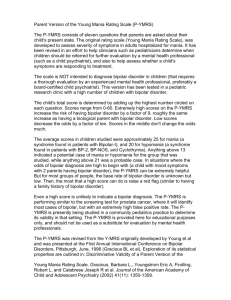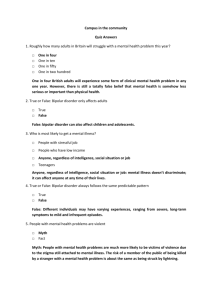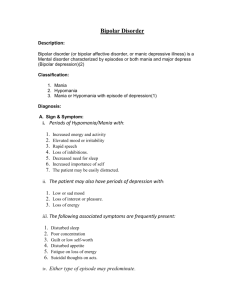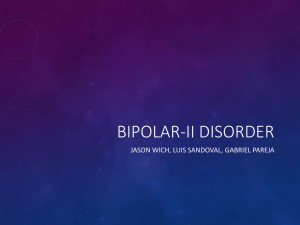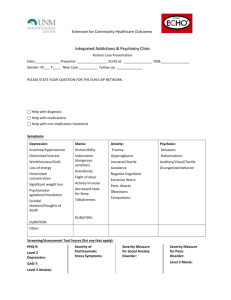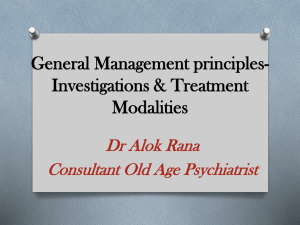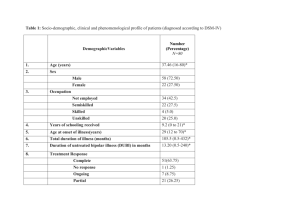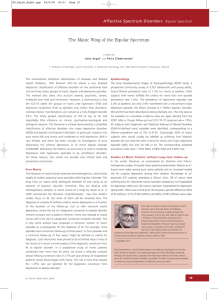Study Synopsis #3 - u.osu.edu.chicken
advertisement
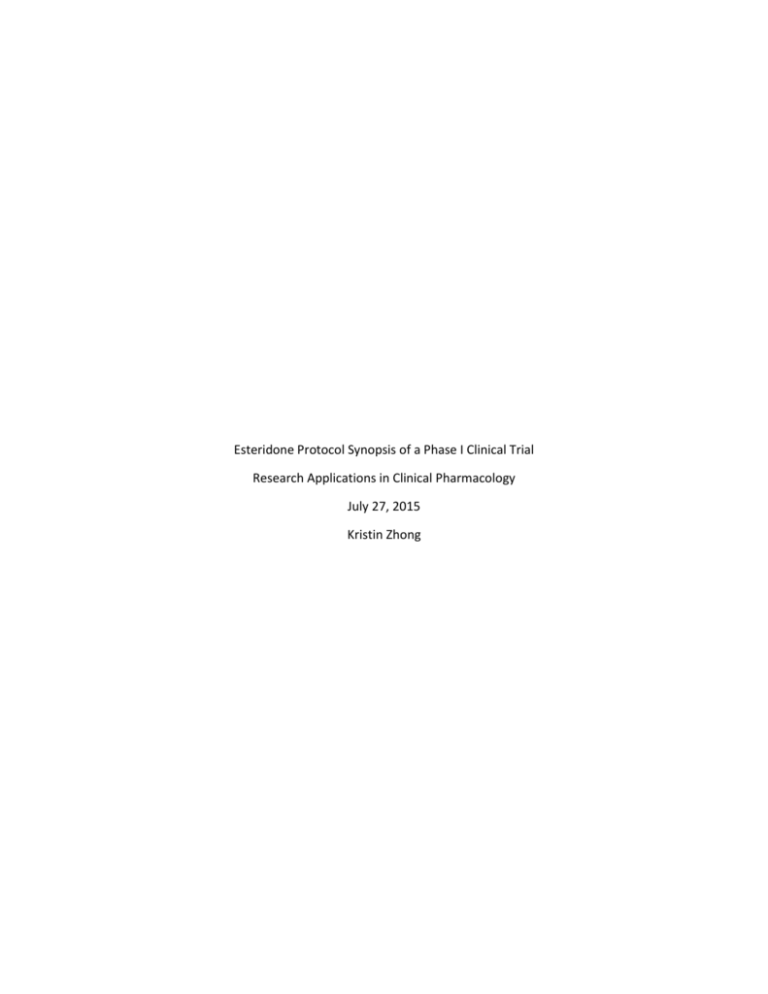
Esteridone Protocol Synopsis of a Phase I Clinical Trial Research Applications in Clinical Pharmacology July 27, 2015 Kristin Zhong Title A Placebo-Controlled, Randomized, Open-Label Study to Investigate the Pharmacokinetics, Side Effect Profile and Efficacy of Esteridone in Patients with Mania and a Diagnosis of Bipolar I Disorder Study Site The Ohio State University OSU Pharmacokinetics and Pharmacodynamics Unit 333 W. 10th Avenue Columbus, OH 43210 Phone: (614) 292-1597 Fax: (614) 292-7232 Objectives The objectives of the study are to evaluate the pharmacokinetics such as drug absorption, distribution, metabolism, and excretion along with safety and efficacy of esteridone in patients who have mania and a diagnosis of bipolar I disorder Esteridone’s activity is primarily due to the parent drug instead of any major metabolites. Elimination of esteridone is done mainly by the hepatic system and there is a mean half-life of 5 hours. Steady state concentrations are reached within one to two days of dosing. The mean apparent systemic clearance is 9 ml/min/kg. Esteridone is likely to interfere with the metabolism of drugs metabolized by the cytochrome P450 enzymes. Esteridone is well absorbed after orally ingested and it reaches peak plasma concentration in 5-7 hours. The absorption of esteridone is increased 1.5-fold in the presence of food. Esteridone has a mean apparent volume of distribution of 1.7 L/kg. Esteridone is bound by greater than 99% to plasma proteins, predominately with albumin. The possibility of drug interactions is not a cause for concern due to displacement. Esteridone is almost completely metabolized after oral administration with a small amount excreted in the urine or feces unchanged. Summary of PreClinical Data Study Design The study design is a placebo-controlled, randomized, open-label study in patients with bipolar disorder. The study drug esteridone, is an atypical antipsychotic. Patients will receive a daily 200 mg oral dose of esteridone every day. There will be a screening period with specific criteria which need to be met before they can be admitted into the OSU Pharmacokinetics and Pharmacodynamics Unit. The screening criteria includes testing on blood glucose levels, urine sampling, and testing of vital signs. There will be a complete physical exam performed by a general medicine medical doctor. A full medical history will be recorded which includes any previous and current medications. There will be a psychiatrist to do an assessment on the bipolar disorder of the subjects. There will be randomization of the subjects into a placebo group or study drug group. The pharmacokinetics of esteridone will be assessed through blood and urine sampling. Side-effect profile will be assessed by a psychiatrist. Efficacy will be assessed through the Young Mania Rating Scale and the Positive and Negative Syndrome Scale. Study Schedule The study will last for 60 days at one facility. There will be mandatory appointments to see physicians twice every two weeks. The subjects will be residing in the facility for the entire period. There will be 50 subjects. Study Therapeutic Esteridone is a new atypical antipsychotic with indications for schizophrenia, bipolar disorder mania, mixed episodes and depression, and as an adjunctive to an antidepressant for major depression. It will be administered orally at 200 mg per day. There will be a need to slowly titrate up to that point at the beginning. Study Population 25 subjects each of men and women who are actively showing signs of mania with their bipolar I disorder diagnosis. Eligibility Criteria Inclusion Criteria: 1. Subject has met the diagnosis of bipolar I disorder from a psychiatrist. 2. They are actively experiencing mania pertaining to their bipolar I disorder diagnosis. 3. Aged from 18 to 50 years of age. Exclusion Criteria: 1. Must have no co-morbidity with bipolar I disorder either physical or psychiatric ailments. 2. Pregnant women. 3. Must not be sexually active if they are women. 4. Must abstain from drinking alcohol. 5. Must abstain from doing illegal drugs. 6. No mixed episodes along with mania. Study End Points Pharmacokinetics of esteridone Side-effect profile of esteridone Efficacy of esteridone Evaluation of End Points Pharmacokinetics of esteridone: The following will be assessed from esteridone, absorption, distribution, metabolism, and excretion. For absorption, the pharmacokinetics parameters include dose, dosing interval, Cmax, absorption rate constant, and bioavailability. For distribution, the pharmacokinetics parameters includes volume of distribution, and concentration. For metabolism, elimination half-life, elimination rate constant, and area under the curve. For excretion, clearance. Side-effect profile of esteridone: Adverse events were observed and recorded. Physical examinations along with blood tests and urine tests are to be done. Vital signs along with electrocardiograms will be measured. Other clinical laboratory tests will be performed to measure the side-effect profile of esteridone. Efficacy of esteridone: The efficacy of esteridone will be based on the reduction of manic symptoms of the subjects who all have bipolar I disorder. This will be measured using the Young Mania Rating Scale which is an assessment test for mania in bipolar I disorder. The Positive and Negative Syndrome Scale will also be used to assess for mania. Procedures SCREENING PERIOD (Days -10 to -1) Patients will need to read and be able to comprehend an informed consent form to be sent for approval to an IRB. They must sign the informed consent form in order to participate in the study. There will be a complete medical exam and health history assessment. All previous and current concomitant medications will be noted. Blood tests, urine testing, and other clinical laboratory tests will be performed. Vital signs will be recorded as well. TREATMENT PERIOD (Days 1 to 60) Day 0 Baseline assessments will be made such as vital signs, blood tests, urine tests, and other clinical laboratory tests. Days 1-60 Every day there will be an oral administration of 200 mg of esteridone for the subjects in the treatment group. For the placebo group they will receive a sugar pill with no therapeutic properties. During days 1-10 there will be a slow titration up to 200 mg for the subjects to better tolerate the drug. Estimated Blood Loss FOLLOW-UP PERIOD (Days 61 to 70) Significant adverse events will be monitored for and recorded if they indeed do happen. If they do occur, a physician will decide whether the subject should immediately curtail esteridone and forcibly drop out of the study. Screening Period Days -10 to -1 50ml (hematology and chemistry) Treatment Period Days 1 to 60 200ml (hematology and chemistry) Follow-up Period Days 61 to 70 60ml (hematology and chemistry) Unscheduled 30ml The estimated blood loss was up to 340ml.
